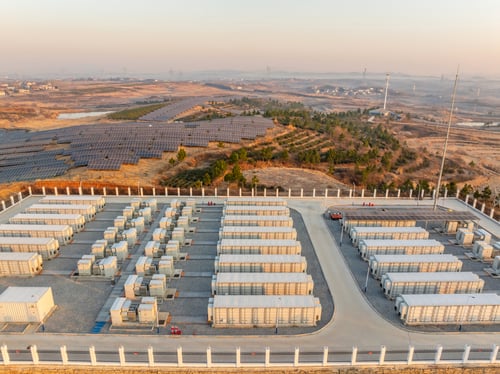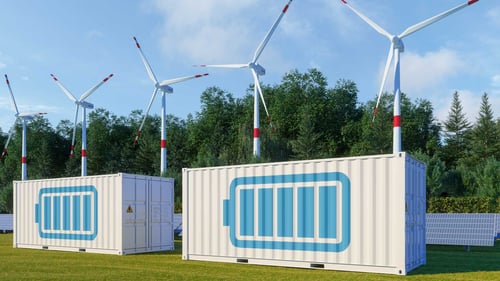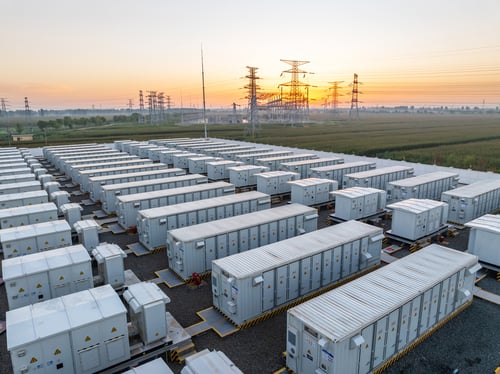What is Battery Storage?

Battery storage is an essential component of the energy transition, accelerating the shift away from fossil fuels towards a fully sustainable energy system. These systems enable the storage of renewable energy, ensuring it can be released when demand is highest. Without battery energy storage systems (BESS), the effective implementation of renewable energy would be challenging, as sources such as wind and solar are inherently volatile and unpredictable.
Energy storage plays a crucial role in capturing and discharging energy. There are various types and sizes of energy storage technologies, but battery storage is poised for significant growth in the coming years and will be a vital part of the clean energy transition. Recent advancements in BESS technology have led to higher cycling limits and longer energy duration, making these systems even more effective and increasing opportunities for their deployment.
As the energy sector evolves and integrates more power from renewables, understanding battery energy storage systems and their capabilities highlights just how crucial they will be to the future of a flexible, reliable, and clean power supply.
Jump to:
- What are Battery Energy Storage Systems?
- How do battery energy storage systems work?
- Types of battery energy storage systems
- Advancements in BESS
- The Future of Battery Energy Storage Systems

What are Battery Energy Storage Systems? (BESS)
Battery energy storage systems use groups of batteries to store electrical energy when it is produced and release it when needed. By capturing excess energy and discharging it later, BESS helps balance supply and demand without requiring additional generation. Among various energy storage technologies, batteries are the most promising for scaling up renewable energy, as they offer flexibility and efficiency in integrating variable power sources.
Expanding energy storage capacity becomes crucial as we transition away from fossil fuels, since renewable sources like wind and solar cannot simply increase output to meet demand surges. Battery storage enables the capture of renewable energy when it is available and its dispatch when required, forming the backbone of a decarbonised, on-demand energy supply.
How do battery energy storage systems work?
BESS are essential for integrating renewable energy into the grid. Since wind and solar are unpredictable, storage is needed to ensure a stable power supply. BESS charges when surplus renewable energy is available and discharges it during high demand, reducing costs and supporting decarbonisation. The International Energy Agency (IEA) estimates that hundreds of gigawatts of battery storage will be required globally in the near future.
Depending on the needs of the electricity transmission service operator (TSO), BESS units can trade stored energy to stabilise supply and demand. While they initially operated in single markets, technological advancements now allow participation in multiple markets simultaneously, on both balancing and wholesale markets.
In balancing markets, BESS units respond to grid fluctuations by rapidly increasing or decreasing output as required. In wholesale markets, they engage in energy arbitrage, charging when prices are low and discharging when demand is high. BESS owners earn payments for providing these services, allowing grid operators to integrate more renewables while creating a more profitable and flexible energy system.
Types of battery energy storage systems
It’s important to make a distinction between the different types of battery storage.
There are various types of battery energy storage systems (BESS) that can be used, and they each have different costs and benefits associated with them. The cost and use cases of each type of battery storage depend on where they are located, how they are managed, and their power capacity and energy capacity.
Grid-scale batteries
Grid-scale battery storage is a technology that enables utilities and power system operators to store large amounts of energy for later use. They are sometimes called front-of-the-meter battery storage systems (FTM) or utility-scale batteries. FTM grid-scale batteries are directly connected to the distribution network. This is important when it comes to energy flexibility schemes.
Behind the meter batteries (BTM Batteries)
Behind-the-meter (BTM) BESS are smaller in their energy storage capacity than grid-scale batteries. They are stationary batteries that are installed on the customer’s site and are connected to the distribution system on the customer's side of the utility's service meter. This means they are not centrally controlled by the distribution network. BTM batteries are usually connected to energy-consuming appliances like machinery, fans, pumps, and combined heat and power (CHP) assets.
Co-located batteries
Co-located batteries are a combination of a battery storage system and another energy-generating asset – which is typically solar. Renewable energy investors are often interested in co-located battery systems as they can be easily installed alongside existing energy projects.
Advancements in BESS
Battery Energy Storage Systems (BESS) have seen significant technological advancements in recent years, making them more efficient, durable, and profitable than ever before. These improvements have enhanced their ability to store and discharge energy, making them a cornerstone of the clean energy transition.
One of the most notable advancements is the increase in cycle limits. Modern BESS units can now endure far more charge and discharge cycles than previous generations, significantly extending their operational lifespan. This improves reliability and increases revenue potential, as batteries can participate in energy markets for longer without the need for costly replacements.
Additionally, longer energy duration has expanded the role of BESS beyond just short-term grid balancing. With the ability to store and discharge energy over extended periods, these systems can now operate across multiple energy markets, including balancing services and wholesale energy trading. By participating in multi-market trading, BESS owners can maximise profitability, taking advantage of price fluctuations and demand shifts across different energy sectors.
These technological advancements have positioned BESS as a key enabler of the energy transition, ensuring a more flexible and resilient power grid while unlocking new revenue streams for investors and operators. As the technology continues to evolve, BESS will play an even greater role in shaping the future of renewable energy integration.
The Future of Battery Energy Storage Systems
Battery energy storage systems (BESS) are critical to the successful transition to a sustainable energy future. They address the inherent volatility of renewable sources like wind and solar, ensuring a reliable and flexible power supply. By storing excess energy and releasing it when demand peaks, BESS balances the grid, reduces costs, and supports decarbonisation. These systems operate by charging during surplus renewable generation and discharging during high demand, with an increasing ability to participate in both balancing and wholesale markets.
Grid-scale, behind-the-meter, and co-located batteries each serve distinct purposes within the energy landscape. Crucially, advancements in BESS technology, such as increased cycle limits and longer energy duration, enhance their efficiency and profitability. These improvements enable BESS to participate in multi-market trading, maximising revenue and solidifying their role as a cornerstone of the clean energy transition. As technology continues to progress, BESS will undoubtedly become even more integral to a flexible, reliable, and decarbonised energy system.
Sympower is an optimiser and route-to-market provider for battery storage (BESS), focusing on providing multi-market optimisation to generate high revenue while preserving asset health. Talk to our team to find out how we can help you secure long-term revenue for your battery project.
Turn your stored energy into profit.
Discover how integrating Battery Energy Storage Systems (BESS) with Demand Response strategies can revolutionise energy management.
Other articles you might find interesting
-
.jpg?length=500&name=electric%20boiler%20(1).jpg) BESS16 October 2024
BESS16 October 2024Beyond revenue potential: navigating the technical complexities of BESS optimisation
Read more -
 BESS16 October 2024
BESS16 October 2024Maximise Battery Revenue: How to Build a Successful Business Case
Read more -
 BESS16 October 2024
BESS16 October 2024The Greek BESS Opportunity: One Market Won’t Do
Read more -
 BESS16 October 2024
BESS16 October 2024Unlocking BESS’ Full Potential: Why Multi-Market Trading is the Future
Read more -
 BESS16 October 2024
BESS16 October 2024Maximising BESS Earnings: 5 Key Revenue Models
Read more -
 BESS16 October 2024
BESS16 October 2024Harnessing BESS’ Potential in the Nordics: Key Insights from our Webinar
Read more
